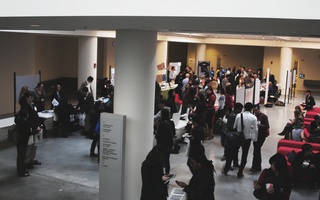One of the iconic features of Harvard’s education is the liberal arts system. The underlying idea is to expose students to a wide variety of types of thinking. In contrast to this age-old academic idea is “innovation,” which seems to be the new buzzword for college campuses and young people. Although these two ideas sit at opposite ends of the timeline, they are inherently and necessarily intertwined.
Many times when we think of innovation in a particular field, we recall the fundamental advancements that drove the whole field forward. There are many examples of this phenomenon: the silicon-based transistor revolutionized the whole computer industry, the impressionist technique of art opened a new way to experience paintings. However, if we look at the truly great innovations of humankind, such as the wheel, writing, and democracy, these innovations have a different flavor. They don’t fit into any existing category―they force a whole new one to be defined.
In today’s world, one of the ways this can be achieved is by examining the intersection of otherwise unrelated fields. The liberal arts lend themselves to this exact approach, as students are exposed to many different subject areas that they can then mix together. Liberal arts are like a palette of primary colors, from which an infinite number of new colors can be mixed.
A classic story of this is Mark E. Zuckerberg and his creation of Facebook. During his time at Harvard, Zuckerberg, a former member of the Class of 2006, took classes in both Computer Science and Psychology. He noticed the concept of a “social network” in his psychology class and combined it with the idea of a “graph” in computer science. And so was born of one of the great tech companies of our generation.
This concept applies to ideas both big and small. Last year, the Harvard Graduate School of Education Innovation and Ventures in Education group hosted its second annual hackathon. Many of the ideas that came out of the event focused on using technology to help solve educational needs―matching high school students to colleges, building tools for the identification of learning disorders, and more. These new and innovative ideas came to be through the combination of concepts from technology, education, psychology, and other fields.
It is pretty obvious from these examples that fields in the humanities and social sciences can lead to new technologies. But can it work the other way?
One of the more popular ideas floating around technology innovation centers like Silicon Valley is “Design Thinking”, or designing products through user empathy. The process consists of identifying user needs, ideating and creating solutions that solve them, and then getting feedback to refine it. For example, at Airbnb, every new employee had to actually use the service within their first week, and based on their experience, identify problems in the service. They would then build new features to help fix these problems, get feedback from users, and change the feature if it was not the most effective.
It turns out that we can apply this same methodology to essay writing. For example, when we revise an essay, we first get the user to test the product, provide feedback, and then reiterate the product to make it a better experience for the user. We keep going through this cycle until the essay satisfies and delights the reader. Great essays can be written by following this process, informed through technology design.
The next wave of great innovations that will push humankind forward is going to be found through a mindset of innovation through the liberal arts. It seems Harvard is committed to following through on this idea. The Harvard Innovation Lab provides resources for students to collaborate on ventures across schools and the School of Engineering and Applied Sciences’ mission statement notes, “To address current and future societal challenges, knowledge from fundamental science, art, and the humanities must all be linked through the application of engineering principles with the professions of law, medicine, public policy, design and business practice.”
These cross-field collaborations are what will ultimately help the University fulfill its mission―preparing students to be citizen-leaders of the future.
Akhil S. Waghmare ’20 is a Crimson Editorial editor in Pforzheimer House.
Read more in Opinion
The Manic Pixie Dream GirlRecommended Articles
-
Proposition 1: Rights, not TaxesTo the Editors of The Crimson: I was fascinated to read, in the same few days, Michael Pakaluk's piece on
-
PLANNING TO PUBLISH CREW SCHEDULE AND STATISTICSAn innovation is being introduced this year by the crew management in regard to the publication of the crew schedule.
-
Kennedy School Scores Energy GrantA Harvard Kennedy School policy research group received a $1.46 million grant last week from a charitable foundation devoted to,
-
Cleaning Our MessHarvard’s reputation in Allston over the past five years has been a little less than stellar, to say the least.
-
 Innovation Summit Encourages Social Entrepreneurship
Innovation Summit Encourages Social Entrepreneurship













